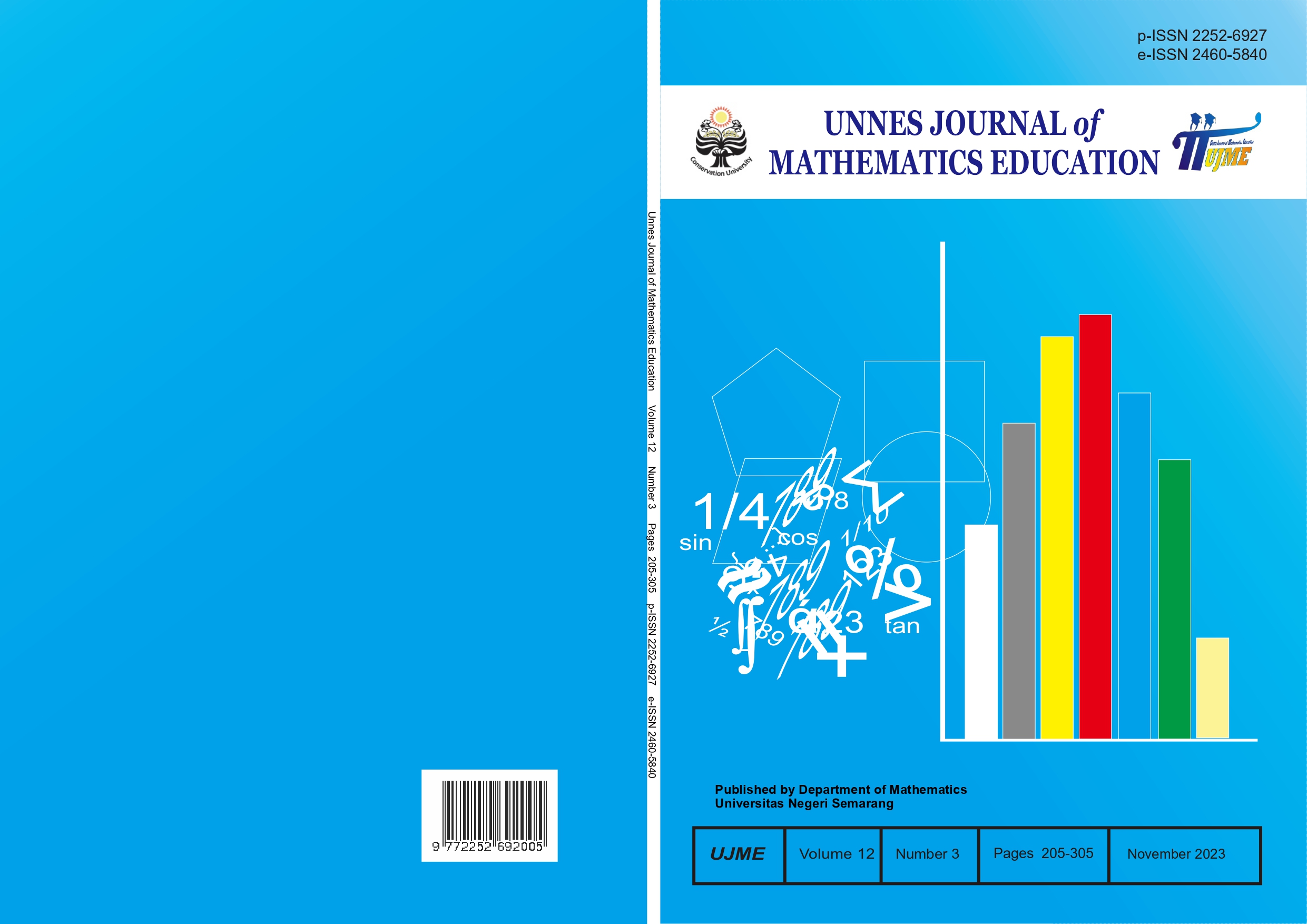An Experimental Study: Creative Problem-Solving Learning Model with Kebumen Tourism Realistic Approach to Improve Numerical Literacy toward 8th-Grade Students
##plugins.themes.academic_pro.article.main##
Abstract
The preliminary study found that students who reached the minimum competency limit of numerical literacy in Asesmen Kompetensi Minimum (AKM) 2021 were less than 50% and below the average value. Thus, this research aimed to determine whether the Creative Problem-Solving (CPS) learning model with Kebumen tourism realistic approach can improve numerical literacy. This research used a quantitative approach which was a quasi-experimental posttest-only design. The population studied was 243 8th-grade students of SMP Negeri 2 Kutowinangun in Kebumen for the academic year 2022/2023 with 2 classes as the sample which was obtained by random sampling. The instruments used were numerical literacy questions paper and the blueprint, answer key, and scoring guidelines. The conclusion was the CPS learning model with Kebumen tourism realistic approach was effective for increasing the numerical literacy of the population rather than the learning model applied by the class teacher. It was proved by these conditions: (1) students’ numerical literacy test mean value in the experimental group achieved individual learning mastery, (2) the proportion of students' numerical literacy test value in the experimental group achieved classical learning mastery, (3) the numerical literacy test mean value of the experimental group is better than the numerical literacy test mean value of the control group.
##plugins.themes.academic_pro.article.details##
References
Azmi, A. L., Wardono, & Cahyono, A. N. (2018). Mathematics Literacy on Creative Problem Solving with Realistic Mathematics Education Approach Assisted by E-learning Schoology. UNNES Journal of Mathematics Education, 7, 188-194. ISSN 2252-6927.
Creswell, J. W. (2012). Educational Research: Planning, Conducting, and Evaluating Quantitative and Qualitative Research (4th ed.). Boston, US: Pearson Education, Inc.
Drábeková, J., Rumanová, L., & Pavlovičová, G. (2022). Numeracy as a Part of Financial Literacy: Student Case Study in Slovakia. International Journal of Emerging Technologies in Learning (iJET), 17(10), pp. 186–199. https://doi.org/10.3991/ijet.v17i10.29659
Ekawati, Rooselyna & Kohar, Ahmad & Hartono, Sriwijanaka. (2017). Experts’ notion and students’ responses on context-based mathematics problem. Journal of Engineering Science and Technology. 12. 53-64.
Hadi, S., & Novaliyosi. (2019). TIMSS Indonesia (Trends in International Mathematics and Science Study). Prosiding Seminar Nasional & Call For Paper (hal. 562-569). Tasikmalaya: Program Studi Magister Pendidikan Matematika Universitas Siliwangi.
Kohar, A. W et al 2019. Profiling context-based mathematics tasks developed by novice PISA-like task designers. J. Phys.: Conf. Ser. 1200 012014. doi:10.1088/1742-6596/1200/1/012014.
Mahdiansyah, & Rahmawati. (2014). LITERASI MATEMATIKA SISWA PENDIDIKAN MENENGAH: Analisis Menggunakan Desain Tes Internasional dengan Konteks Indonesia. Jurnal Pendidikan dan Kebudayaan, 20(4), 452-469.
Mardiana, D., Yuni, Y., & Atiyyah, R. (2019). Perbedaan Hasil Belajar Matematika Siswa Melalui Model Realistik dan Ekspositori. Prosiding Seminar Nasional Pendidikan STKIP Kusuma Negara (hal. 1-9). Jakarta, Indonasia: STKIP Kusuma Negara.
Masrukan. (2017). Asesmen Otentik Pembelajaran Matematika, Mencakup Asesmen Afektif dan Karakter. Semarang, Indonesia: FMIPA Universitas Negeri Semarang.
Nur, Iyan R.D., Herman, T., & Dahlan, T.H. (2022). Numeracy Literacy in Early Childhood: An Investigation in Arithmetic, Geometry and Patterns in Early Stage. JTAM (Jurnal Teori dan Aplikasi Matematika), 6(2), 308-320. P-ISSN 2597-7512, E-ISSN 2614-1175.
OECD (2019), PISA 2018 Results (Volume I): What Students Know and Can Do, PISA, OECD Publishing, Paris, https://doi.org/10.1787/5f07c754-en.
Ovan, & Nugroho, S. E. (2017). Analisis Kemampuan Literasi Matematika Ditinjau dari Metakognisi Siswa pada Model PISA-CPS. Unnes Journal of Mathematics Education Research, 6(1), 96-102. p-ISSN 2252-6455; e-ISSN 2502-4507.
Purwaningrum, J.P., Ahyani, L.N., & Utomo, A.P. (2022). The Need for A Digital Module to Improve The Numerical Literacy of Dyscalculia Students. KALAMATIKA Jurnal Pendidikan Matematika, 7(1), 99-110. P-ISSN 2527-5615, E-ISSN 2527-5607.
Salgado, F.J.A.. (2017). The Role of Context and Context Familiarity on Mathematics Problems. Revista Latinoamericana de Investigación en Matemática Educativa (2017) 20 (3): 265-292. DOI: 10.12802/relime.17.2031.
Suminar, R.K. & Rahman, I.N. (2022). Mathematical Problem Solving Ability to Develop Numerical Literacy in Elementary School Students. Prima: Jurnal Pendidikan Matematika, 6(2), 120-131. P-ISSN 2579-9827, E-ISSN 2580-2216.
